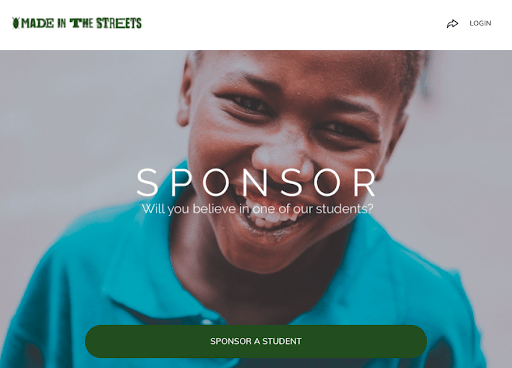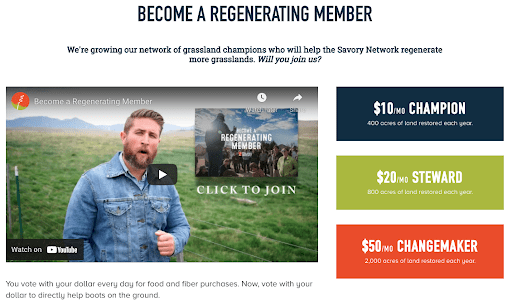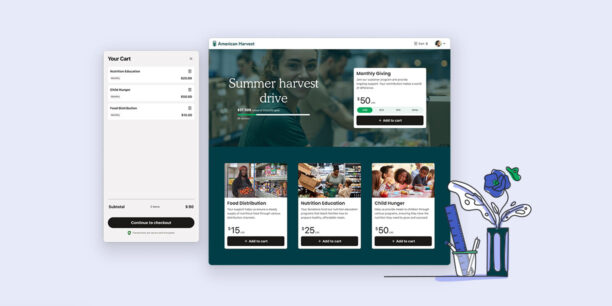5 Types of Recurring Giving Programs to Consider

Request a Demo
Learn how top nonprofits use Classy to power their fundraising.
Recurring gifts provide your nonprofit with consistent revenue during uncertain economic times and build lasting relationships with donors. Your organization, then, needs to decide which type of recurring giving program or strategy is best tailored for your community and would incentivize these recurring donations.
There are five main approaches your nonprofit may want to consider if you’re looking to build or expand your recurring giving program. Below, we’ll explain how each of these approaches work and highlight their benefits and downsides.
Download the Ultimate Guide to Recurring Giving
1. Grow Recurring Giving Organically
The first approach you can take to recurring giving is to let it happen organically rather than having a specific program. When a supporter fills out a donation form, there will be an option to check a box to make that donation recurring.
The benefit of this approach is that it’s easy to add recurring as an option on your donation form. Since supporters are organically choosing whether or not to click the button, there’s no big time commitment to managing recurring donations this way.
Learn How to Optimize Your Donation Page
However, the downside to this approach is that you might not see as much success compared to programs that specifically target recurring donations. People typically won’t give a recurring gift unless they’re asked.
2. Create a Membership Program
Membership programs are an approach to recurring giving that invite your donors to join a “community” of recurring givers. A nonprofit may offer the members of this community certain benefits or perks, such as VIP event tickets, appreciation events, branded membership pins, or other swag.
Many nonprofits will also create a specific name for that community and special branding for the program.
For example, Canal Alliance is a nonprofit working “to break the generational cycle of poverty for Latino immigrants and their families by lifting barriers to their success.” They call their recurring donors “Aliados,” meaning allies. On their donation page, they explain why this community is so important: “Aliados (or ‘allies’) of Canal Alliance are committed advocates of immigrants who make a recurring investment in support of the dreams of hard-working immigrants and families in Marin.”

The key benefit to this approach is that it makes recurring donors feel more valued and connected to a group of like-minded supporters. This is a great marketing strategy as it provides a community feel rather than coming across as transactional.
A potential downside to this approach is that it does require a larger time commitment to keep up with specific member communications, promised incentives, and other program-specific tasks. However, these can all lead to an elevated donor experience that builds loyalty from your supporters.
3. Offer a Sponsorship Opportunity
Another approach to recurring giving programs is to frame the donation as a way to sponsor a specific child, family, animal, or other recipient of your nonprofit’s services.
For example, Made In The Streets is a nonprofit working to “love and serve children from the streets of Nairobi, Kenya – meeting their physical, emotional, and spiritual needs; loving them fully; equipping them to earn a living and sending them out to a new life.” Its recurring giving program focuses on sponsoring a specific student, and supporters receive updates and stories on how their contribution has impacted the health and wellbeing of children in the nonprofit’s care.

A key benefit to this recurring giving approach is that it makes the donation experience more personalized and meaningful. Donors feel close and connected to the beneficiary of their gift. Some nonprofits may even be able to facilitate having the child or family write letters to the donor to further build an emotional connection to the cause.
However, one thing to consider with this approach is that typically donations from recurring giving programs are put into a general fund rather than directly sponsoring a specific child or family. This isn’t always the case, but if it is, you may have some challenges with your messaging to ensure you’re not misleading your supporters. That’s why Made In The Streets takes special care to communicate directly with donors about how funds in this program are used.
4. Encourage Giving Levels With Incentives
Incentive-based programs encourage recurring giving by offering unique incentives for each gift amount.
For example, Savory Institute is a nonprofit looking “to facilitate the large-scale regeneration of the world’s grasslands and the livelihoods of their inhabitants, through holistic management.” To encourage recurring gifts, they offer three tiers of giving levels, ranging for $10 to $50 a month, with additional perks at each level. These perks include access to online courses, swag, discounts on partner brands, 1-on-1 time with Savory staff, and more.

A benefit to this recurring giving program approach is that incentives can lead to higher donation amounts. In addition, these types of benefits are a nice way to say thank you to your donors as they’re choosing to join your cause.
The downside to this approach is that it can be difficult for some nonprofits to afford the incentives. You’ll need to ask whether it’s worth it to spend money on these items, given the impact you expect it to have on acquiring recurring donors. You may also want to see if one of your local partners or a corporate sponsor might be willing to help. Consider what low-budget items you may also be able to swing to save costs.
5. Highlight Items to Exchange for a Recurring Gift
A final approach you can take to your recurring giving strategy is an exchange program. Exchange programs show items people could sacrifice in exchange for a recurring gift.
For example, Love146 is a nonprofit aiming to end child trafficking and exploitation. They used an exchange program to encourage new recurring donors during a month-long campaign. They showed how supporters could skip things like a $3 movie rental or $7 Lyft ride per month to make a donation instead.

The benefit of an exchange program approach is that it’s a good way to motivate donors by showing how easy it is to make an impact.
Test this approach with your specific audience, as this might make more sense for, and appeal to, younger donors. A time-specific promotional campaign might be a good opportunity to see if this resonates with your supporters.
Connect With Your Supporters Through the Right Recurring Giving Program
Regardless of which type of recurring giving program you choose, remember that communication and relationship building with your donors is what’s most important.
Focus your energy on making donors feel appreciated, special, and valued. If you need to sacrifice incentives to improve your communication with donors, do it. The goal is to keep your donors happy and build relationships with them that will retain and grow their support over time.
To learn more about building a successful recurring giving program, download the Ultimate Guide to Recurring Giving today. Our comprehensive guide will help you discover how to set goals and measure your program’s success, elevate your program with distinct branding elements, craft a compelling email appeal, and more.

The Ultimate Guide to Recurring Giving
Subscribe to the Classy Blog
Get the latest fundraising tips, trends, and ideas in your inbox.
Thank you for subscribing
You signed up for emails from Classy
Request a Demo
Learn how top nonprofits use Classy to power their fundraising.
 Explore Classy.org
Explore Classy.org 

